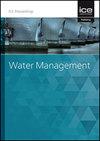Scour countermeasures around cylindrical pier by using downscaled W weir
IF 0.9
4区 工程技术
Q3 ENGINEERING, CIVIL
Proceedings of the Institution of Civil Engineers-Water Management
Pub Date : 2023-09-04
DOI:10.1680/jwama.22.00026
引用次数: 0
Abstract
Scour is a significant concern for bridge design and maintenance, and scour countermeasures are often used to prevent or reduce erosion caused by scouring. The W weir is a grade control structure that serves many purposes, including scour controls at the bridge pier. A series of laboratory experimental runs were carried out by changing the size and height along with its location from the pier to the weir to optimize the structural configuration of downscaled W weir. It is observed from the experiments that the scour hole profile at the upstream of the downscaled W weir changes with the height of the weir. When the height of the weir was 1.0D (D = diameter of the pier), two small depressions of almost identical size were observed inside the main scour hole, one just in front of each upstream apex of the W weir. One cone-shaped scour hole was observed when the height of the W weir was 0.5D with its maximum depth in between the upstream apexes. The reduction of scour in front of the pier was more when the height of the weir was 1.0D. The maximum scour control achieved among all the different structural combinations of downscaled W weir was 47.66%. The maximum scour control was achieved when the downscaled W weir had a 2.0D size with the height of 1.0D placed at a 2.0D distance from the pier.缩小W型堰的圆柱墩冲刷对策
冲刷是桥梁设计和维修中重要的问题,通常采用冲刷对策来防止或减少冲刷造成的侵蚀。W堰是一种控制坡度的结构,有多种用途,包括控制桥墩的冲刷。通过改变尺寸和高度以及从桥墩到堰的位置,进行了一系列的实验室试验,以优化缩小W堰的结构配置。实验结果表明,缩小后的W型堰上游冲刷孔剖面随堰高的变化而变化。当堰高为1.0D (D =桥墩直径)时,在主冲刷孔内观察到两个大小几乎相同的小洼地,一个位于W堰上游顶点的正前方。当W堰高度为0.5D时,观察到一个锥形冲刷孔,其最大深度在上游尖顶之间。当堰高为1.0D时,墩前冲刷减小幅度更大。不同结构组合对W堰冲刷的最大控制效果为47.66%。当缩小后的W堰尺寸为2.0D,高度为1.0D,与桥墩距离为2.0D时,可以实现最大的冲刷控制。
本文章由计算机程序翻译,如有差异,请以英文原文为准。
求助全文
约1分钟内获得全文
求助全文
来源期刊
CiteScore
2.10
自引率
0.00%
发文量
28
审稿时长
6-12 weeks
期刊介绍:
Water Management publishes papers on all aspects of water treatment, water supply, river, wetland and catchment management, inland waterways and urban regeneration.
Topics covered: applied fluid dynamics and water (including supply, treatment and sewerage) and river engineering; together with the increasingly important fields of wetland and catchment management, groundwater and contaminated land, waterfront development and urban regeneration. The scope also covers hydroinformatics tools, risk and uncertainty methods, as well as environmental, social and economic issues relating to sustainable development.

 求助内容:
求助内容: 应助结果提醒方式:
应助结果提醒方式:


